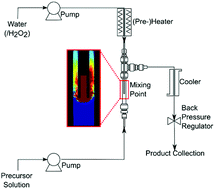Assessing the life cycle environmental impacts of titania nanoparticle production by continuous flow solvo/hydrothermal syntheses†
Abstract
Continuous-flow hydrothermal and solvothermal syntheses offer substantial advantages over conventional processes, producing high quality materials from a wide range of precursors. In this study, we evaluate the “cradle-to-gate” life cycle environmental impacts of alternative titanium dioxide (TiO2) nanoparticle production parameters, considering a range of operational conditions, precursors, material properties and production capacities. A detailed characterisation of the nano-TiO2 products allows us, for the first time, to link key nanoparticle characteristics to production parameters and environmental impacts, providing a useful foundation for future studies evaluating nano-TiO2 applications. Five different titanium precursors are considered, ranging from simple inorganic precursors, like titanium oxysulphate (TiOS), to complex organic precursors such as titanium bis(ammonium-lactato)dihydroxide (TiBALD). Synthesis at the laboratory scale is used to determine the yield, size distribution, crystallinity and phase of the nanoparticles. The specifications and operating experience of a full scale plant (>1000 t per year) are used to estimate the mass and energy inputs of industrial scale production for the life cycle assessment. Overall, higher process temperatures are linked to larger, more crystalline nanoparticles and higher conversion rates. Precursor selection also influences nano-TiO2 properties: production from TiOS results in the largest particle sizes, while TiBALD achieves the smallest particles and narrowest size distribution. Precursor selection is the main factor in determining cradle-to-gate environmental impacts (>80% in some cases), due to the production impact of complex organic precursors. Nano-TiO2 production from TiOS shows the lowest global warming potential (GWP) (<12 kg CO2-eq. per kg TiO2) and cumulative energy demand (CED) (<149 MJ kg−1 TiO2) due to the low environmental impact of the precursor, the use of water as a solvent and its high yield even at lower temperatures. Conversely, the TiBALD precursor shows the highest impact (86 kg CO2-eq. per kg TiO2 and 1952 MJ kg−1 TiO2) due to the need for additional post-synthesis steps and complexity of precursor manufacturing. The main purpose of this study is not a direct comparison of the environmental impacts of TiO2 nanoparticles manufactured utilizing various precursors under different conditions, but to provide an essential foundation for future work evaluating potential applications of nano-TiO2 and their life cycle environmental impacts.



 Please wait while we load your content...
Please wait while we load your content...